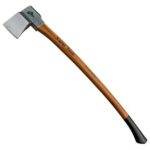An axe is one of the most versatile tools you can find in many homes, but they come in different types suited for different activities. That said, if you are going to be splitting a lot of wood to keep yourself and your family warm in the winter, you will find it much easier if you have the right axe for the task.
Splitting axes and mauls are designed with wider profiles and cheeks to cut in parallel with the wood grains. Unlike general purpose and felling axes, splitting axes come with relatively heavier axe heads and a flat, hammer-like side that you can use to drive splitting wedges into the wood.
They are also designed with an excellent balance and blade shape, providing much-needed power and efficiency when splitting woods.
With the right splitting axe, you can split and stock your own firewood, ultimately saving money on wood.
If you’re planning to split your own firewood and are overwhelmed by the options in the market, this post will help you pick one of the best splitting axes. Read on to find the things you should consider when buying an axe for splitting wood and, of course, some of the best axes you can buy.
Top 9 Axes for Splitting Wood Comparison Table
| Image | Name | Length | Weight | Rating (1-5) |
|---|---|---|---|---|
 | 1. Fiskars 378841-1004 X27 Super Splitting Axe | 36 inches | 5.85 pounds | 4.8 |
 | 2. Husqvarna Wooden Splitting Axe | 30 inches | 3.5 pounds | 4.7 |
 | 3. Gransfors Bruks Outdoor Axe | 14.75 inches | 1.2 pounds | 4.6 |
 | 4. 1844 Helko Werk Germany Saxon Splitting Axe | 31 inches | 8.5 pounds | 4.8 |
 | 5. INTERTOOL Steel Splitting Maul | 35 inches | 6.6 pounds | 4.5 |
 | 6. Hooyman Splitting Maul | 36 inches | 8 pounds | 4.5 |
 | 7. Truper 30957 6-Pound Splitting Maul | 36 inches | 8.21 pounds | 4.5 |
 | 8. Cold Steel All-Purpose Axe | 23 inches | 2.95 pounds | 4.6 |
 | 9. JXE JXO Splitting Axe | 35.4 inches | 6.72 pounds | 4.6 |
Things to Consider When Choosing an Axe for Splitting Wood
Axes can be, and most often, are job-specific in nature. While general-purpose axes are ideal for completing cutting, splitting, felling, and shaping wood, the best splitting axes are designed to split along the grain of the wood, breaking the fibers apart and ultimately creating small chunks.
As we all know, the right tool makes all the difference.
Here are the key considerations when purchasing a new axe for splitting wood:
1. The Weight You Can Handle
An axe is a useful tool that you need as a homeowner. While these tools do an excellent job when it comes to chopping your own wood, it is worth noting that they use your energy, not any other type of fuel. That’s why it is extremely important to consider the weight you can handle before buying your wood-splitting axe.
Generally, heavier axes pack more power with each swing and will be more effective in breaking the wood fibers apart. As such, it is a good idea to choose a reasonably heavy axe that you can handle without any hassle.
2. The Material of the Axe Handle
Handles of wood splitting axes are typically made out of three different materials:
- Hardwood
- Fiberglass composite
- Forged steel covered with rubber or similar material for a firm grip
Wood handles are very common because they are lightweight, offer a firm grip, and absorb shock associated with splitting firewood. Fiberglass axe handles are soft to touch and absorb some shock but tend to shatter when used in extreme temperature conditions.
Splitting axes with steel handles usually have the handles forged in a single piece combining the axe head and the handle.
Although the right handle depends on many factors, including personal preferences, steel handles are the most durable. The only major concern is that they do not absorb shock like other options.
However, this should not worry you because many manufacturers nowadays cover steel handles with rubber or shock-absorbing material to help dampen the shock that goes in your hands when splitting.
The handle that you will choose will depend on your budget and preference.
3. The Length of the Axe Handle
The length of the axe handle is as important as its material. Considering that longer handles bring more velocity and more power with every swing, it is best to go by the longest handle that feels comfortable for you.
The idea is to choose a handle length that allows you to work comfortably and easily. After all, you won’t find a long-handled axe effective if you can’t handle the force it takes from you in every swing.
Before settling on a long axe handle, remember that hitting a precise spot on a log becomes slightly more difficult with each extra inch of the handle. That said, you can start with a shorter handle and advance as you master the skill of splitting firewood.
It turns out that it is all about comfort and easiness on your body when working.
4. Solid Piece vs. a Multi-Piece Axe
A wood-splitting axe can be a solid piece or come with the axe head and handle apart, each with a set of benefits.
While many people love multi-piece axes because it is relatively easier to sharpen the axe heads, there is an unforeseen danger of the axe head flying off inadvertently. On the other hand, solid piece axes can hardly separate, which makes them a safer option.
In this case, the best option depends on your preference.
5. Head Materials
As the name suggests, splitting axes come ready for the task of splitting firewood. However, this doesn’t mean they are of the same quality.
Axes from reputed manufacturers come with heads made from high-quality or high carbon steel, which makes them more durable and sharper relative to axe heads made with low-quality steel. When doing your search, you might also encounter heads with anti-corrosion coatings, which helps them last longer.
Heads made with high-quality carbon steel are suited for all types of wood. They are also heftier and deliver higher output.
Top 3 Best Axe for Splitting Wood Reviews
The enjoyment of the glowing ambiance of a wood-burning fireplace is priceless, but buying firewood can be costly. To save money on firewood, here are some of the best axes you pick to split your own wood.
1. Fiskars 378841-1004 X27 Super Splitting Axe

The Fiskars 378841-1004 X27 Super Splitting Axe is an excellent tool that lives up to the reputation of Fiskars. At its core, it is a 36-inch axe that comes with a very sharp and relatively thin head that widens dramatically towards the handle. This long-handled axe is suited for taller users and is designed to split medium- to large-sized logs.
At 5.85 pounds, Fiskars X27 requires strength and coordination to swing, but once its ultra-sharp edge strikes, it leaves a considerably powerful cut.
Like other Fiskars axes, X27 combines perfect weight distribution and advanced blade geometry, allowing you to swing speedily and make every swing your best with deeper chops. With a low-friction blade coating, it means that this axe will practically never get stuck in the wood.
Fiskars X27 Super splitting axe comes with a fiberglass composite handle known for absorbing some of the shock of each strike. Besides, the handle has a textured, non-slip grip that improves control and reduces strain on the hand. A flared end promises elevated safety.
Considering that Fiskars has been making and selling chopping tools since the seventeenth century, you can be sure that you are getting a high-quality and reliable tool.
2. Husqvarna Wooden Splitting Axe

Husqvarna is another highly regarded name in the world of axes. When the only feel of a real wood handle will do, check out the Husqvarna Wooden Splitting Axe. This 3.5-pound axe is made of hickory and hand-forged Swedish steel.
It is a great choice for homeowners looking for splitting power of a traditional wood axe packed in a lightweight axe.
This splitting axe is designed with a geometry that penetrates the wood and forces it apart with little effort. Its long handle utilizes a two-hand grip, providing remarkable power while splitting firewood.
There were some problems with quality control and axe heads breaking a few years ago, but these issues have been addressed in the most recent models.
Husqvarna 30-inch wooden splitting axe is best suited for splitting thicker wood.
3. Gransfors Bruks Outdoor Axe

At about 1.2 pound, the Gransfors Bruks Outdoor Axe is a great splitting axe light enough for you to carry around in your outdoor missions. Because it is lightweight with a relatively long handle, sharp edge, and short stature, you can use it to chop and split firewood or even cut trees with one hand without using so much energy.
The axe head is 2.5 inches and perfectly stamped with smith’s initials. Its 14.75-inch hickory handle is boiled in linseed oil and rolled in beeswax giving it its smooth and water repellent finish that makes it easy to handle when splitting wood.
It is equipped with a steel collar beneath the head for extra protection when cutting and crafting wood.
Gransfors Bruks Outdoor Axe is supplied with a leather sheath for proper storage, which helps in maintaining the sharp edge.
Frequently Asked Questions
Is a Heavier Axe Better for Splitting Wood?
In most cases, it is safe to say that a heavier axe is better for splitting wood. The weight of an axe determines the momentum generated to split wood. As such, a heavier axe provides more power to split along the wood grains and break the fibers apart.
However, heavier doesn’t always mean better-suited for your needs.
Do You Season Wood Before Splitting?
Although it is best to season wood before splitting it, wood does not necessarily need to be seasoned before splitting. Splitting green firewood is relatively easy and speeds up the “seasoning” process.
If you are looking to season your firewood as fast as possible, make sure to cut the logs into lengths and split them before stacking.
What is the Best Way to Split Firewood?
The best method and tool for splitting firewood will depend on a number of factors, including your skill level and the size of wood you are splitting. For most people, the best approach for splitting wood is using a splitting axe and maul.
How Do You Split Fresh Cut Wood?
Splitting fresh-cut wood is similar to splitting dry wood, only that it tends to be a little more difficult. All you need is to cut through the wood.
If you are struggling to split wet with an axe, consider investing in a log splitter.
How Do You Split Wood for Beginners?
An axe is arguably the best tool for beginners for splitting firewood. To split wood, place your logs on the chopping block and examine it for weak points like cracks.
Next, assume a reasonable stance (feet spread shoulder-width apart), then aim your axe or maul to run the same direction as the line of weakness. Swing the axe successfully until the wood splits.
Does Wood Split Easier Green or Dry?
The simple answer to this question is that it’s easier to split green wood. The reason for this is that when the wood starts drying out, its fibers begin to shrink, which makes it harder to split apart.
What is the Hardest Wood to Split?
According to many homeowners, the hardest wood to split is elm and sweetgum.
Do You Wait for Wood to Dry Before Splitting?
While you can split the wood when it is still wet, it is best to let it dry first. Dry (seasoned) wood has a low moisture content, which makes it easier to split.
Of significance, you don’t necessarily need to wait for the wood to dry before splitting.
Does Splitting Wood Make it Dry Faster?
Yes, splitting wood speeds up the drying process. If you want your firewood to dry faster, split the logs before stacking.
Conclusion
Splitting axes are incredibly useful tools for splitting wood, but the right tool for you depends on your specific needs. If you are planning to split your own firewood, hopefully, this post will help you get the right tool to get the job done.




